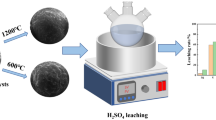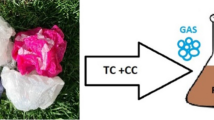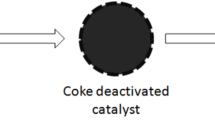Abstract
Equilibrium fluid-catalytic-cracking catalyst (E-cat), a waste catalyst from fluid-catalytic cracking in petroleum refining, was used to catalyze acetalization of aldehydes (ketones) with diols. Although the activity of E-cat in catalytic cracking has decreased, it still presented fine catalytic performance in the acetalization. The ketal was stoichiometrically formed in the reaction of cyclohexanone with ethanediol, conversion of the ketone reached to 99.7% and selectivity of the ketal maintained 100% in the optimum conditions. It was revealed that E-cat can be provided with the wide adaptability in acetalization from the syntheses of different kinds of acetals or ketals. Moreover, E-cat appeared a superreusability through filtration from the reaction flask. It was an attracted example for decrement from the bulk waste catalyst in petroleum refining.








Similar content being viewed by others
References
Letzsch W (2008) Fluid catalytic cracking (FCC). Springer Netherlands, Berlin
Song HT, Da ZJ, Zhu YX, Tian HP (2011) Effect of coke deposition on the remaining activity of FCC catalysts during gas oil and residue cracking. Catal Commun 16:70–74. https://doi.org/10.1016/j.catcom.2011.09.001
Martínez NP, Andrés MQP (1992) A new approach on catalytic cracking catalyst deactivation. Catal Lett 13:383–387. https://doi.org/10.1007/BF00765041
Ferella F, Innocenzi V, Maggiore F (2016) Oil refining spent catalysts: a review of possible recycling technologies. Resour Conserv Recycl 18:10–20. https://doi.org/10.1016/j.resconrec.2016.01.010
Furimsky E (1996) Spent refinery catalysts: environment, safety and utilization. Catal Today 30:223–286. https://doi.org/10.1016/0920-5861(96)00094-6
Vogt ET, Weckhuysen BM (2015) Fluid catalytic cracking: recent developments on the grand old lady of zeolite catalysis. Chem Soc Rev 44:7342–7370. https://doi.org/10.1039/C5CS00376H
Chen L, Zeng J, Guan C, Zhang H, Yang R (2015) High gradient magnetic separation in centrifugal field. Miner Eng 78:122–127. https://doi.org/10.1016/j.mineng.2015.04.018
Sun D, Li XZ, Brungs M, Trimm D (1998) Encapsulation of heavy metals on spent fluid catalytic cracking catalyst. Water Sci Technol 38:211–217. https://doi.org/10.1016/s0273-1223(98)00530-7
Liu LL, Liang YY, Song QB, Li JH (2017) A review of waste prevention through 3R under the concept of circular economy in China. J Mater Cycles Waste Manag 19(4):1314–1323. https://doi.org/10.1007/s10163-017-0606-4
Akcil A, Veglio F, Ferella F, Okudan MD, Tuncuk A (2015) A review of metal recovery from spent petroleum catalysts and ash. Waste Manag 45:420–433. https://doi.org/10.1016/j.wasman.2015.07.007
Liu HH, Ma JT, Gao XH (2006) Synthesis, characterization and evaluation of a novel resid FCC catalyst based on in situ synthesis on kaolin microspheres. Catal Lett 110(3–4):229–234. https://doi.org/10.1007/s10562-006-0113-z
Al-Jabri K, Baawain M, Taha R, Al-Kamyani ZS, Al-Shamsi K, Ishtieh A (2013) Potential use of FCC spent catalyst as partial replacement of cement or sand in cement mortars. Constr Build Mater 39:77–81. https://doi.org/10.1016/j.conbuildmat.2012.05.035
Chen HL, Tseng YS, Hsu KC (2004) Spent FCC catalyst as a pozzolanic material for high-performance mortars. Cem Concr Comp 26:657–664. https://doi.org/10.1016/S0958-9465(03)00048-9
Mohammad FA, Mohammad N, Siddiqui SHHR (2004) Study on the conversion of waste plastics/petroleum resid mixtures to transportation fuels. J Mater Cycles Waste Manag 6(1):27–34. https://doi.org/10.1007/s10163-003-0102-x
Salmiaton A, Garforth A (2007) Waste catalysts for waste polymer. Waste Manag 27:1891–1896. https://doi.org/10.1016/j.wasman.2006.07.024
Valanciene E, Miknius L, Martynaitis V, Striugas N (2017) Influence of equilibrium fluid catalytic cracking catalyst amount on the thermolysis process of various polyolefin plastic wastes in a fixed-bed reactor for gasoline and diesel production. Energ Fuel 31:11194–11210. https://doi.org/10.1021/acs.energyfuels.7b01472
Bertero M, Puente GDL, Sedran U (2013) Products and coke from the conversion of bio-oil acids, esters, aldehydes and ketones over equilibrium FCC catalysts. Renew Energ 60:349–354. https://doi.org/10.1016/j.renene.2013.04.017
Tonetto G, Atias J, de Lasa H (2004) FCC catalysts with different zeolite crystallite sizes: acidity, structural properties and reactivity. Appl Catal A-Gen 270:9–25. https://doi.org/10.1016/j.apcata.2004.03.042
Greene TW, Wuts P (1999) Protecting groups in organic synthesis. Sheffield Academic Press, Sheffield
Climent MJ, Velty A, Corma A (2002) Design of a solid catalyst for the synthesis of a molecule with blossom orange scent. Green Chem 4:565–569. https://doi.org/10.1039/b207506g
Piasecki A, Sokołowski A, Burczyk B, Kotlewska U (1997) Synthesis and surface properties of chemodegradable anionic surfactants: sodium (2- n -alkyl-1,3-dioxan-5-yl) sulfates. J Am Oil Chem Soc 74:33–37. https://doi.org/10.1007/s11746-997-0115-z
Kłosowski G, Czupryński B (2006) Kinetics of acetals and esters formation during alcoholic fermentation of various starchy raw materials with application of yeasts Saccharomyces cerevisiae. J Food Eng 72:242–246. https://doi.org/10.1016/j.jfoodeng.2004.12.001
Reddy PS, Sudarsanam P, Mallesham B, Raju G, Reddy BM (2011) Acetalisation of glycerol with acetone over zirconia and promoted zirconia catalysts under mild reaction conditions. J Ind Eng Chem 17:377–381. https://doi.org/10.1016/j.jiec.2011.05.008
Wu LP, Moteki T, Gokhale Amit A, Flaherty David W, Toste FD (2016) Production of fuels and chemicals from biomass: condensation reactions and beyond. Chem 1:32–58. https://doi.org/10.1016/j.chempr.2016.05.002
Zhang FM, Shi J, Shi Y, Fu Y, Zhong Y, Zhu W (2015) Facile synthesis of MIL-100(Fe) under HF-free conditions and its application in the acetalization of aldehydes with diols. Chem Eng J 259:183–190. https://doi.org/10.1016/j.cej.2014.07.119
Yan W, Chen KK, Zhang XF, Kuang YY, Tang XJ, Han XX (2015) Synthesis of novel Brønsted-Lewis acidic ionic liquid catalysts and their catalytic activities in acetalization. J Ind Eng Chem 29:185–193. https://doi.org/10.1016/j.jiec.2015.04.002
Han X, Ouyang K, Xiong C, Tang X, Chen Q, Wang K, Liu LL, Hung CT, Liu SB (2017) Transition-metal incorporated heteropolyacid-ionic liquid composite catalysts with tunable Brønsted/Lewis acidity for acetalization of benzaldehyde with ethylene glycol. Appl Catal A-Gen 543:115–124. https://doi.org/10.1016/j.apcata.2017.06.024
Shylesh S, Sahida Sharma SP, Mirajkar AP Singh (2004) Silica functionalised sulphonic acid groups: synthesis, characterization and catalytic activity in acetalization and acetylation reactions. J Mol Catal A-Chem 212:219–228. https://doi.org/10.1016/j.molcata.2003.10.043
Mathieu Y, Corma A, Echard M, Bories M (2014) Single and combined Fluidized Catalytic Cracking (FCC) catalyst deactivation by iron and calcium metal–organic contaminants. Appl Catal A-Gen 496:451–465. https://doi.org/10.1016/j.apcata.2013.10.007
Bayraktar O, Kugler EL (2003) Visualization of the equilibrium FCC catalyst surface by AFM and SEM–EDS. Catal Lett 90:155–160. https://doi.org/10.1023/B:CATL.0000004110.98820.d9
Psarras AC, Iliopoulou EF, Nalbandian L, Lappas AA, Pouwels C (2007) Study of the accessibility effect on the irreversible deactivation of FCC catalysts from contaminant feed metals. Catal Today 127:44–53. https://doi.org/10.1016/j.cattod.2007.05.021
Wallenstein D, Farmer D, Knoell J, Fougret CM, Brandt S (2013) Progress in the deactivation of metals contaminated FCC catalysts by a novel catalyst metallation method. Appl Catal A-Gen 462:91–99. https://doi.org/10.1016/j.apcata.2013.02.002
Sing SW (1985) Reporting physisorption data for gas/solid systems. Pure Appl Chem 57:603–619
Behera Babita, Ray Siddharth S (2009) Structural changes of FCC catalyst from fresh to regeneration stages and associated coke in a FCC refining unit: a multinuclear solid state NMR approach. Catal Today 141:195–204. https://doi.org/10.1016/j.cattod.2008.03.017
Cerqueira HS, Caeiro G, Costa L, Ribeiro FR (2008) Deactivation of FCC catalysts. J Mol Catal A-Chem 292:1–13. https://doi.org/10.1016/j.molcata.2008.06.014
Clerici A, Pastori N, Porta O (1998) Efficient acetalisation of aldehydes catalyzed by titanium tetrachloride in a basic medium. Tetrahedron 30:15679–15690. https://doi.org/10.1002/chin.199918079
Acknowledgements
The authors are grateful for the support extended to this work by the National Natural Science Foundation of China (No. 21776068 and 21606082).
Author information
Authors and Affiliations
Corresponding authors
Ethics declarations
Conflict of interest
The authors declare no conflict of interest.
Additional information
Publisher's Note
Springer Nature remains neutral with regard to jurisdictional claims in published maps and institutional affiliations.
Rights and permissions
About this article
Cite this article
Zhang, D., Wen, B., Chen, Y. et al. Reuse of waste catalytic-cracking catalyst: fine performance in acetalization. J Mater Cycles Waste Manag 22, 22–29 (2020). https://doi.org/10.1007/s10163-019-00909-2
Received:
Accepted:
Published:
Issue Date:
DOI: https://doi.org/10.1007/s10163-019-00909-2




